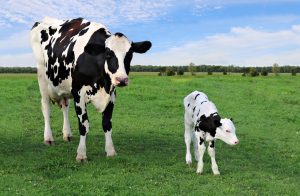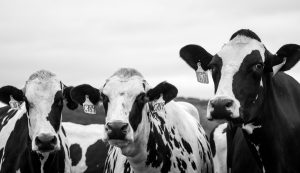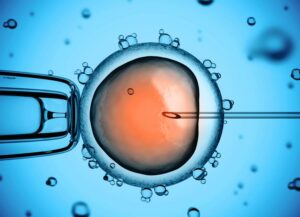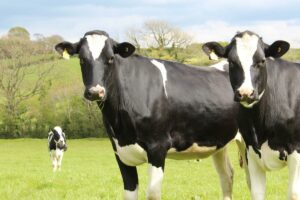Mercedes Gonzalez
Climate change is the main challenge we face nowadays. Its main consequence is the sustained and unstoppable increase in ambient temperatures that cause cows to suffer greater heat stress, which negatively and globally affects their production. The dairy sector will need to develop new strategies to raise animals that can better cope with these changes.
When temperature rise, neurons send signals to the hypothalamus and trigger physiological, anatomical and behavioral responses in cows in order to maintain thermal balance. These responses are aimed at producing changes in their physiology (digestive, metabolic and hormonal), reducing feed intake, milk production and quality, and leading also to some immunosuppression. Therefore, increases in ambient temperatures increase costs of production and reduces farm profitability.
The most milk-producing cow breeds, Holsteins and Jerseys, are genetically more adapted to cold environments. They are currently distributed all over the world in all types of climates, so in some regions they are subjected to great thermal stress.
In general, Holsteins produce more milk and are more sensitive to changes in temperature, humidity, airflow and solar radiation. Jerseys have a different productive phenotype, with less milk production, but with more protein and fat.
Previous studies have shown that Holsteins produce 97% of their normal production when the ambient temperature is 29°C and relative humidity is 40%. Jerseys on the other hand drop to 93%, but when relative humidity rises to 90%, production is 65% relative to normal in Holsteins and 75% in Jerseys. Other studies described Jerseys acclimating better to warm, humid environments compared to Holsteins, maintaining more consistent production.
The genetic differences between both breeds does not sufficiently explain their physiological differences on themselves, suggesting that there might be other factors that could lead to these differences, such as differences in the ruminal microbiome. A study (Dong-Hyeon et al., 2020) was conducted in the Republic of Korea evaluating changes in the ruminal microbiome in Holstein and Jersey cows exposed to heat stress.
In the term microbiome we include all genes present in the resident microbial population of the cow’s rumen. It seeks to identify differences to heat stress in the functional characteristics and metabolites of the ruminal microbiome through metagenomic (microbial genetic material examination), and metabolomic analyses (study of the biochemical processes in which its metabolites are involved).
The hypothesis in this study was that ambient temperature alters the ruminal microbiome, which in turn can influence heat stress resistance in both breeds. Two groups of Holstein and Jersey cows were selected and subjected to stabled experimental conditions during the hottest months of the year (May to August) in barns with forced ventilation and fed a total mixed ration ad libitum.
Heat stress was assessed based on the temperature-humidity index (THI) as defined by the National Research Council, rectal temperature and respiratory rate. Ruminal liquid samples were taken to extract microbial DNA from the rumen microbes and genetically sequence the strains.
Holsteins are more sensitive to ambient temperature than Jerseys
Significant differences were observed in ruminal metabolites and metabolic pathways between both breeds. Taxonomic and genetic differences were also found in the ruminal bacteria present in both groups.
Under heat stress conditions (THI 87.5), Holsteins showed higher respiratory rates (98.4 cycles/minute) than Jerseys (81.8 cycles/minute) compared to normal conditions (THI 69.6). In addition, rectal temperatures increased in Holsteins (39.8°C) but not in Jerseys (38.7°C). These results indicated that Holsteins are more sensitive to ambient temperature than Jerseys.
The composition of the ruminal microbiome was different in both breeds
Regarding microbial diversity, the results indicated that heat stress affected both breeds independently, as changes in the composition of the ruminal microbiome were observed when subjected to thermal stress, and these differences were significant between both breeds.
The efficiency of ruminal microbial metabolism is intimately related to heat generation in rumen, and this heat generation can be estimated indirectly through bacterial growth. The interaction between the efficiency of microbial metabolism (including methane and heat production) in rumen is not currently known exactly, but there is a possibility that inefficient metabolic responses from rumen bacteria will exaggerate heat production in Holsteins under heat stress conditions.
Conclusions
This study concluded that Jerseys show a more moderate heat stress response than Holsteins and this could be due to a difference in the composition of the ruminal microbiome. These differences in ruminal flora account for certain bacterial species that could be a heat-generating source in Holsteins. Jersey cows showed more obvious changes in bacterial species and genetic functional abundance, making them more easily adaptable to climate changes.
Reference
Kim Dong-Hyeon, Kim Myung-Hoo, Kim Sang-Bum, Son Jun-Kyu, Lee Ji-Hwan, Joo Sang-Seok, Gu Bon-Hee, Park Tansol, Park Beom-Young, Kim Eun-Tae. Differential dynamics of the ruminal microbiome of Jersey cows in a heat stress environment, Animals. 2020 Jul; 10(7):1127-1135.
© 2020 Dairy Knowledge Center. All Rights Reserved.











